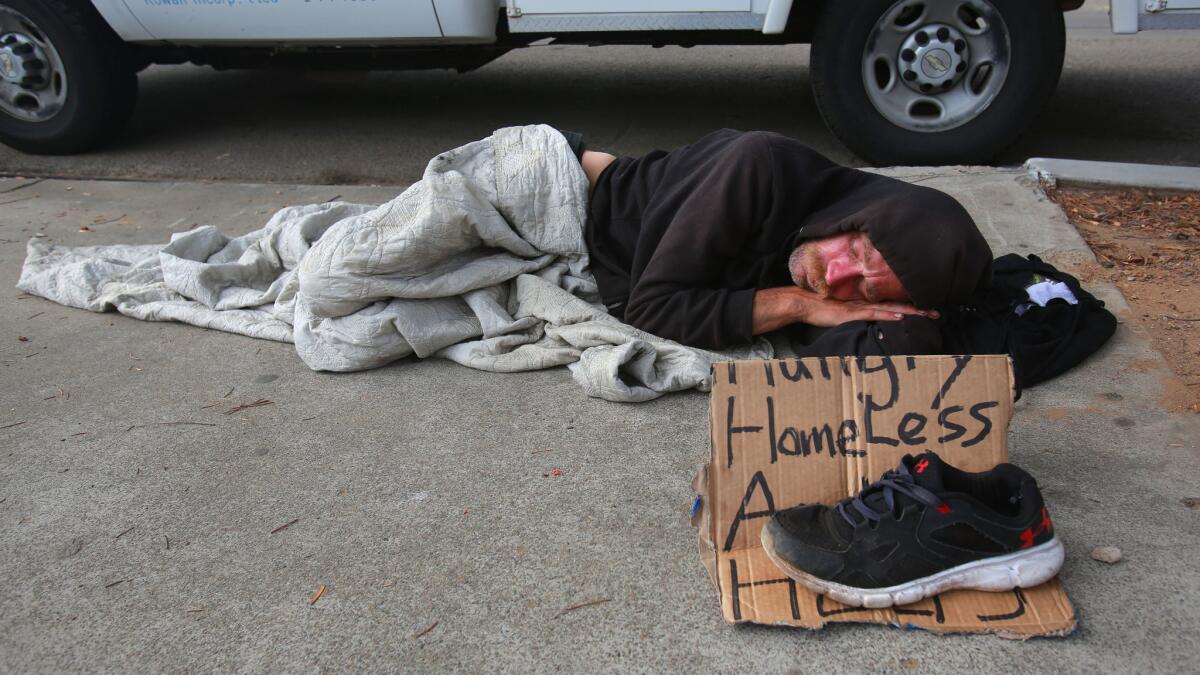San Diego officials are seeking more federal aid for the homeless

- Share via
Reporting from SAN DIEGO — Civic leaders in San Diego are preparing to make a case to get more federal funding to help the homeless after years of receiving less than other cities with fewer people on the street.
“Ending homelessness in San Diego is a bold goal that can only be achieved if we receive our fair share of resources,” Rep. Scott Peters (D-San Diego) said at a news conference last week at Father Joe’s Village in downtown San Diego.
San Diego County receives federal funding for homeless programs from the Department of Housing and Urban Development, which bases its funding on a formula that many local advocates have said shortchanges the region.
San Diego at times has had the third-largest homeless population in the country, but ranked 18th in the amount of federal funds received to address the issue, officials said.
HUD Secretary Julian Castro announced late last month that the formula used to distribute money for homeless programs will be revised. The department has proposed four alternative funding programs, with each expected to bring more money for San Diego County.
Of an estimated $100 million spent on helping the homeless in San Diego County each year, about $18 million came from HUD last year. Revising the formula is expected to bring an additional $2 million or $3 million.
HUD is accepting public comments through late September on the four proposed alternative formulas.
The formula HUD has been using gives more money to communities based on the age of its housing and whether the population is decreasing or not growing as fast as the rest of the country. The federal government uses a similar formula to fund community development block grants.
Rick Gentry, the San Diego Housing Commission president and chief executive, said that the formula favored the East Coast but hurt the West Coast, which has newer housing and a growing population.
Gentry said all four proposed alternatives would benefit San Diego and other cities on the West Coast because they give greater weight to issues more directly related to homelessness.
A fifth alternative yet to be proposed could bring the area even more money, Gentry said.
“If we give even greater weight to housing affordability, it would help not only San Diego but the whole West Coast,” Gentry said. The fifth alternative also would give more weight to mental health and substance abuse issues.
Although HUD did not ask for alternatives to the proposed formulas, Gentry said another one could be proposed because the department had asked for public comment.
“We’re saying, ‘These are all fine and we’ll rate them, and by the way, have you thought of this other way of doing this?’” he said.
Gentry said he would like all groups working on homelessness throughout the county to be in agreement when they make a pitch for one new funding formula.
It’s unclear when, or even if, any new funding formula would go into effect. Peters said that although Castro’s announcement indicated a change was coming, he was not considering it money in the bank.
No matter what formula is adopted, speakers at Wednesday’s news conference all agreed a change was long overdue.
“At Father Joe’s, we’re frequently asked what we need to help more,” said Bill Bolstad, vice president of capital development for Father Joe’s Villages, reading a statement from Deacon Jim Vargas, the organization’s president and chief executive. “The bottom line is we need more funding.”
Bolstad said Father Joe’s Villages helped more than 800 people get off the street last year, but could have helped more if it had more resources.
“For the last several years, the point-in-time count has indicated that approximately 8,700 homeless people are here in San Diego County on any given night,” Bolstad said. “That’s a staggering figure. What’s more staggering is that it doesn’t have to be that way.”
Jerry Sanders, president and chief executive of the San Diego Regional Chamber of Commerce, said homelessness is an economic issue.
“At the end of the day, San Diego’s substantial homeless population is evidence that we need to protect and create more jobs,” he said, adding that the chamber has been working with the mayor’s office and Housing Commission on the issue.
The funding formula alternatives are scheduled to be discussed at the Aug. 18 meeting of the Regional Continuum of Care Council, an association of 18 cities within the county, various nonprofit service providers and other homeless services advocates.
The care council oversees federal dollars that come to the region to address homelessness.
San Diego City Councilman Todd Gloria, governance board chair of the care council, said the goal of ending homelessness is being pursued throughout the county by civic leaders, including Mayor Kevin Faulconer and County Supervisor Ron Roberts, who attended the news conference.
“The city and county of San Diego are together at the helm of the Regional Continuum of Care,” he said. “We’re working closer than we ever have before on this problem because it is so very important, and this partnership is essential to our continual progress in trying to end homelessness in San Diego.
Warth writes for the San Diego Union Tribune
More to Read
Sign up for Essential California
The most important California stories and recommendations in your inbox every morning.
You may occasionally receive promotional content from the Los Angeles Times.













